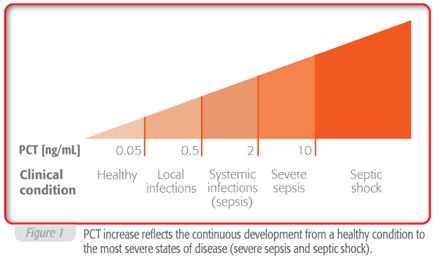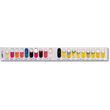Sepsis Diagnostics

Sepsis can be defined as the body's reaction to infection (bacterial, viral, fungal, parasitic) which may lead to a systemic inflammatory reaction and eventually organ dysfunction and/or failure.
For More
Information
Although sepsis may develop from any type of infection, the ones that most frequently cause the disease are bronchopulmonary, abdominal, and urinary tract infections.
Depending on the severity of the condition, it is classified in one of three groups: sepsis, severe sepsis, and septic shock (in increasing order of severity). Definitions for the terms “SIRS”, “sepsis”, “severe sepsis” or “septic shock” have been proposed by the ACCP/SCCM consensus conference in 1992, and are now widely used (see table below 1).1
|
Table 1 SIRS and sepsis definition (ACCP/SCCM-criteria) |
|
|
SIRS (Systemic Inflammatory Response Syndrome) |
2 or more of the following criteria:
|
|
Sepsis |
Documented infection together with 2 or more SIRS criteria |
|
Severe Sepsis |
Sepsis associated with organ dysfunction, including, but not limited to, lactic acidosis, oliguria, hypoxemia, coagulation disorders, or an acute alteration in mental status |
|
Septic Shock |
Sepsis with hypotension, despite adequate fluid resuscitation, along with the presence of perfusion abnormalities. Patients who are on inotropic or vasopressor agents may not be hypotensive at the time when perfusion abnormalities are detected |
Clinical need for earlier detection of sepsis
Early detection and specific clinical intervention has been shown to be crucial for the improved outcome of patients with sepsis. However, sepsis can be difficult to distinguish from other, non-infections conditions in critically ill patients with clinical signs of acute inflammation and negative microbiological results. Therefore, in the early phase of the disease process it may be difficult to decide on the appropriate therapeutic measures for the individual patient.
Additional specific information may be helpful to increase the accuracy of sepsis diagnosis at an early stage. A parameter which fulfills these demands to a high degree is procalcitonin.
Fast and highly specific PCT increase in bacterial infection and sepsis
Procalcitonin (PCT) is often increased during systemic bacterial infection and sepsis. This biomarker is now being recognized as a useful tool in the diagnostic process. It has been shown that PCT can contribute to optimization of antibiotic therapy and monitor treatment duration1.
One major advantage of PCT compared to other parameters is its early and highly specific increase in response to severe systemic bacterial infections and sepsis.2,3 Therefore, in septic conditions, increased PCT levels can be observed 3-6 hours after an infectious challenge.
PCT levels are usually low in viral infections, chronic inflammatory disorders or autoimmune processes. PCT levels in sepsis are generally greater than 0.5-2 ng/mL and often reach values between 10 and 100 ng/mL, or considerably higher in individual cases, thereby enabling diagnostic differentiation between these various clinical conditions and a severe bacterial infection (sepsis) (Figure 1).
|
1. Bone RC, Balk RA, Cerra FB, Dellinger RP, Fein AM, Knaus WA, Schein RM, Sibbald WJ. Definitions for sepsis and organ failure and guidelines for the use of innovative therapies in sepsis. The ACCP/SCCM Consensus Conference Committee. American College of Chest Physicians/Society of Critical Care Medicine. Chest 1992; 101: 1644-55. 2. Harbarth S, Holeckova K, Froidevaux C, Pittet D, Ricou B, Grau GE, Vadas L, Pugin J; Geneva Sepsis Network. Diagnostic value of procalcitonin, interleukin-6, and interleukin-8 in critically ill patients admitted with suspected sepsis. Am J Respir Crit Care Med. 2001; 164: 396-402. 3. Muller B, Becker KL, Schachinger H, Rickenbacher PR, Huber PR, Zimmerli W, Ritz R. Crit Care Med. 2000; 28: 977-83. Calcitonin precursors are reliable markers of sepsis in a medical intensive care unit. |
bioMérieux Solutions for Diagnostics of Sepsis:
- WorkSafe Blood Culture Collection Kits – Implement best practices, improve patient care, reduce collection errors, accurately track septicemia, and control costs
- BACT/ALERT® 3D – Automated microbial detection system for clinical and product safety applications
- BACT/ALERT® 3D Culture Media – bioMérieux is the only manufacturer to offer blood culture media in plastic bottles
- VITEK® 2/VITEK® 2 Compact – Systems for rapid microbial identification and antibiotic susceptibility testing
- API® – Manual test kits for microorganism identification
- VIDAS® B·R·A·H·M·S PCT™ – Diagnosis of bacterial infections and sepsis; rapid procalcitonin assay used with critically ill patients to assess risk for progression to severe sepsis and septic shock







